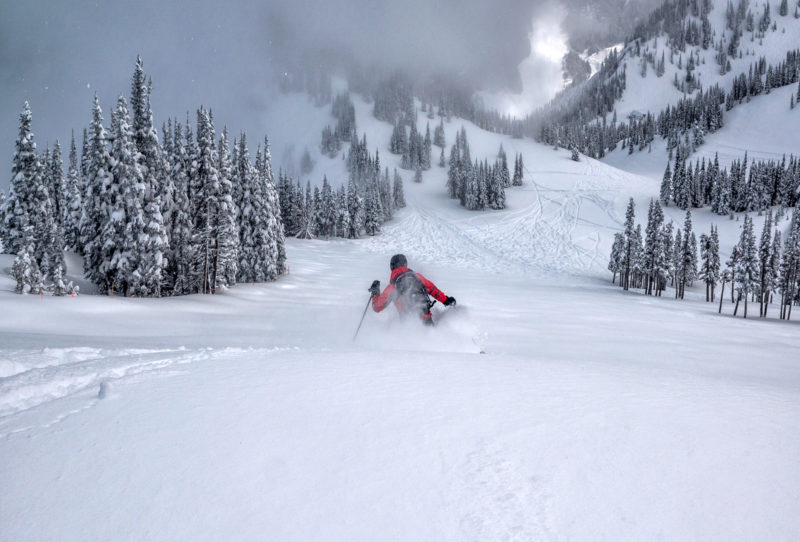
Theresa Sippel, DPT, Staff Physical Therapist
People often think about strengthening their quads in preparation for ski season. The quadriceps muscles (quads for short) are your anterior thigh muscles and may be strengthened with exercises like wall sits, squats and lunges. While these are great base exercises, it is important to also strengthen your glutes (buttock muscles) and hamstrings (muscles in the back of your thigh). It is important to train all of these leg muscles to work well together in order to best support your legs.
It’s also important to train muscles using the same movements that they will make during the activity. This is called specificity of training. Skiing requires a contraction of the quads and hamstrings/glutes at the same time, in order to maintain a proper stance, adjust to changes in terrain, and power through turns. The hip abductors (the muscles on the outside of your hips), core abdominal, and low back muscles are also important for keeping your trunk and upper body stable while carving turns. As you are adjusting to the terrain on the slope, your muscles are repeatedly shortening and lengthening. When you drive forward you are using the glutes and hamstrings to extend. As you absorb the turn, or when you land from a jump, you are using your quads. Plyometrics, or jumping activities, are a great way to train all of these muscles to closely match what they will do while skiing.
Skiing consists of short bursts of activity followed by longer rest periods (if you’re riding the chair lift that is!). If you’re touring, endurance is much more important for the uphill part. But the downhill part is pretty much the same – ski for 30-60 seconds, stop, and let your friends catch up. If you’re really ripping laps, you may ski for up to 3 minutes at a time before stopping. This is how you should train! Circuit training is great for this. It consists of a high intensity exercise, usually for 30-60 seconds at a time, followed by a rest for the same amount of time or longer.
The second component of a well-rounded training program is balance. Balance as a concept can be divided up into two different areas: reactive control and anticipatory control. Reactive control happens when the body reacts to its surroundings through information from the visual system (eyes), vestibular system (inner ear) and sensory system (receptors in the joints and skin). Anticipatory control happens when the body makes a movement in anticipation of a potential unstable situation in order to remain balanced. Confused? Let’s apply those situations to skiing. Your body needs to be able to react to any loss of balance you did not expect; that is reactive control. You can see obstacles in front of you and decide which direction you should go or what position your body needs to be in; that is anticipatory control.
In order to train reactive control you need to create an environment that your body needs to react to. This can be done using something to create an unstable surface, such as a ½ foam roller, a BOSU ball or a dyna disc, etc. A couch cushion works great too! Start with standing on one leg on the unstable surface. Your body has to react to any loss of balance created by the unstable surface. To add an additional degree of difficulty, have a friend toss a ball to you while you’re standing on one foot on the foam.
In order to train anticipatory control you need to create instability with an anticipated movement. One example is a hip hinge exercise. It is also great for training hip stability. Stand on one foot, then slowly lean forward, keep your back straight and hinge at the hip as you raise the opposite leg straight behind you. Pause when you feel a pull in the back of your thigh and then stand back up. Make sure to keep your hips level (do not rotate!) throughout the movement. Perform the exercise in front of a mirror to check your form. As your center of gravity moves forward, lifting your leg helps maintain your balance by keeping your weight centered over your foot.
The final component of a well-rounded training program is flexibility. Overall the recent research on the benefits of stretching has been inconclusive. The big takeaway seems to be that not everyone needs to stretch! If you have proper length in your muscles, then stretching is not needed. However it has been found that sports involving bouncing and jumping activities may require a more compliant muscle-tendon unit (a muscle and the tendon that attaches it to the bone), and some focused stretching exercises can be helpful. Skiing definitely involves lots of jumping and bouncing! So, if you have muscle length imbalances, it is important to do some stretching before the season starts.
Proper length in your calf is important in order to be able to drive the ski boot forward. Proper length in the hip muscles (specifically quad, hip flexor, hamstring and piriformis) is important to take pressure off the knees and allow normal mechanics when carving your turns.
Here are some ideas for stretches based on what you find in your quick screen. Each stretch should be held for 30-60 seconds.
The calf is made up of two major muscles: the gastrocnemius and the soleus. Both are important to stretch in order to allow proper motion at the ankle. In order to stretch the gastroc, step forward with one foot, placing your hands against a wall and push your back heel into the ground. Make sure to keep your toes pointing straight forward. To stretch the soleus, simply get into the same position as the gastroc stretch and bend your knee. This puts the gastroc muscle on slack and allows for a stretch of the soleus muscle.
The hamstrings and quads both extend from the hip to the knee. An easy way to stretch your hamstrings is to use a door way or corner. Sit on the floor with your butt as close to the wall as possible, then lay back and place your leg up on the wall, keeping your knee straight. If you are not able to keep your knee straight, you’re too close to the wall! Move back a little and try again.
A great stretch for your quads is the sidelying quad stretch. Lie on your side, pull your foot back toward your butt and hold onto your ankle. Start with your knee in front of your hip in order to stretch the quad. To incorporate the hip flexors more, extend at the hip, but do not allow your back to arch. If you feel your back arching, think about pulling your belly button toward your spine in order to engage your abdominal muscles. If you still feel your back arching, ease off the stretch.
Last but certainly not least, the piriformis. To stretch, lie on your back with both knees bent. Bring one foot to the opposite knee and pull the whole lower leg towards your stomach.
 For more ideas on exercises, we have developed a training program you can follow for the month of October.
For more ideas on exercises, we have developed a training program you can follow for the month of October.
It starts with basic strengthening exercises and progresses to some plyometric activities. This will give you a good progression to follow for the month. The calendar is also posted on our Facebook page at www.facebook.com/GPTseattle. We will be posting videos of the corresponding exercises each week.
We will also be hosting a “Training for Ski Season” event in partnership with Arc’teryx Seattle at Ascent Outdoors on October 17th. Please see our Facebook page for more details on this event!